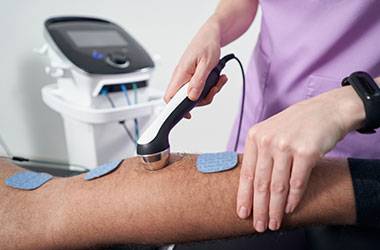At Complete Chiropractic Sports and Wellness, we offer state-of-the-art, non-surgical solutions to manage spinal health. One of our most effective treatments for chronic back and neck pain is Spinal Decompression Therapy. This innovative, non-invasive therapy is FDA APPROVED and designed to gently stretch the spine, relieve pressure on the discs and nerves, and promote long-term healing for various spinal conditions.
Spinal Decompression Therapy
Spinal Decompression Therapy in Durham, NC
What is Spinal Decompression Therapy?
Spinal Decompression Therapy is a traction-based treatment designed to alleviate pressure on the spinal discs and nerves. By gently stretching the spine, the therapy creates negative pressure within the discs, encouraging them to retract and relieving nerve compression. This reduction in pressure allows oxygen, nutrients, and water to flow into the affected areas, promoting healing and reducing pain.
The therapy is a popular treatment option for individuals suffering from herniated or bulging discs, sciatica, degenerative disc disease, and other conditions that result in chronic pain. Unlike surgical interventions, Spinal Decompression Therapy is a safe, non-invasive approach with minimal risk and no downtime.
How Does Spinal Decompression Work?
Spinal Decompression Therapy utilizes a specialized traction table or device to carefully stretch the spine. This controlled, gentle stretching process helps:
- Relieve pressure on spinal discs: Spinal decompression reduces the pressure within the discs, allowing bulging or herniated discs to retract, which alleviates nerve compression and reduces pain.
- Improve nutrient and oxygen flow: By decompressing the spine, the therapy allows essential nutrients and oxygen to reach the damaged discs, promoting tissue repair and faster healing.
- Reduce nerve compression: As discs retract, pressure on nearby nerves is alleviated, helping to relieve conditions such as sciatica, which causes pain radiating down the legs.
- Restore spinal alignment: Spinal decompression can help realign the spine, improving posture, mobility, and overall spinal health.
This process helps treat the root causes of back and neck pain, providing lasting relief rather than merely masking symptoms.
The Science Behind Spinal Decompression
Spinal decompression therapy is grounded in the principles of biomechanics and neurophysiology. The spine is composed of vertebrae, intervertebral discs, and nerve pathways, all of which work together to provide structural support and movement while protecting the spinal cord. Over time, spinal discs can become compressed due to aging, repetitive strain, poor posture, or injury. This compression can lead to disc herniation, nerve impingement, and chronic pain.
During spinal decompression therapy, controlled mechanical forces are applied to the spine, creating a negative intradiscal pressure. This negative pressure stimulates a process called imbibition, where spinal discs absorb nutrients and hydration, allowing them to regain volume and elasticity. The decompressive effect also promotes circulation to spinal tissues, reducing inflammation and encouraging cellular repair.
Additionally, spinal decompression influences nerve function by relieving pressure on compressed nerve roots. When a nerve is compressed, it can cause pain, numbness, or weakness that radiates to different parts of the body. By reducing nerve compression, spinal decompression therapy restores proper nerve signaling and improves overall mobility and function.
Conditions Treated with Spinal Decompression Therapy
Spinal Decompression Therapy has been clinically validated to be effective in treating various spinal conditions, including:
- Herniated or Bulging Discs: When a spinal disc becomes damaged or displaced, it can press on nearby nerves, causing pain and discomfort. Spinal decompression relieves this pressure, allowing the disc to heal naturally.
- Degenerative Disc Disease: As we age, the discs in our spine can shrink and lose their cushioning effect. Spinal decompression helps alleviate pressure on the bones and nerves, reducing pain associated with this condition.
- Sciatica: Sciatica occurs when the sciatic nerve is compressed, causing pain that radiates down the lower back and legs. Decompression therapy helps reduce the compression, easing sciatic pain.
- Spinal Stenosis: Spinal stenosis is the narrowing of the spinal canal, which can put pressure on the nerves. Decompression therapy widens the space between the vertebrae, reducing this pressure and relieving pain.
- Facet Syndrome: Facet joints are the joints between the vertebrae, and facet syndrome occurs when these joints become inflamed. Decompression therapy helps alleviate the stress on the joints, reducing inflammation and pain.
- Chronic Lower Back or Neck Pain: If you have been experiencing persistent pain that has not responded to other treatments, Spinal Decompression Therapy could provide the relief you need.
Comparison with Other Spinal Treatments
Spinal decompression therapy is one of several treatment options for spinal conditions. Below is a comparison of how it differs from other common approaches:
1. Spinal Decompression vs. Chiropractic Adjustments
- Spinal Decompression: Focuses on gently stretching the spine to create space between the vertebrae and relieve pressure on discs.
- Chiropractic Adjustments: Involves quick, controlled thrusts to realign the spine and improve joint mobility.
- Best For: Chronic disc issues, nerve compression, herniated discs (spinal decompression) vs. misalignments and joint dysfunction (chiropractic adjustments).
2. Spinal Decompression vs. Physical Therapy
- Spinal Decompression: Passively stretches the spine to relieve nerve compression and improve disc health.
- Physical Therapy: Focuses on strengthening the muscles surrounding the spine through targeted exercises.
- Best For: Severe disc-related pain (spinal decompression) vs. rehabilitation after an injury (physical therapy).
3. Spinal Decompression vs. Surgery
- Spinal Decompression: Non-invasive, uses traction forces to reduce disc pressure.
- Surgery (e.g., discectomy, spinal fusion): Involves removing or fusing parts of the spine, often with risks of complications and long recovery times.
- Best For: Mild to moderate spinal conditions (spinal decompression) vs. severe spinal injuries that do not respond to conservative care (surgery).
4. Spinal Decompression vs. Pain Medications
- Spinal Decompression: Treats the underlying cause of pain by restoring spinal disc function.
- Pain Medications: Mask symptoms temporarily but do not address the root cause.
- Best For: Long-term relief and healing (spinal decompression) vs. short-term symptom management (medications).
Benefits of Spinal Decompression Therapy
Spinal Decompression Therapy offers several benefits, particularly for individuals who want to avoid surgery or medication:
- Non-surgical treatment: Spinal decompression is a non-invasive treatment, meaning there is no need for incisions or anaesthesia. It also requires no recovery time, allowing patients to return to their normal activities immediately after treatment.
- Effective pain relief: Many patients experience relief from back and neck pain after just a few sessions, with improvements continuing over time.
- Long-term results: Unlike medications, which may only mask symptoms, spinal decompression addresses the root cause of the pain, promoting long-term healing and relief.
- Minimal risk: Spinal decompression is a gentle therapy that is well-tolerated by most patients. There are few side effects, making it an ideal option for people who want to avoid the risks of surgery.
- Restores spinal health: In addition to relieving pain, spinal decompression helps improve spinal alignment, which can enhance posture, mobility, and overall health.
What to Expect During a Spinal Decompression Therapy Session
At Complete Chiropractic Sports and Wellness, we tailor each Spinal Decompression Therapy session to your specific needs. Before beginning treatment, our chiropractic team will perform a thorough evaluation to determine if decompression therapy is the right option for you.
During your session, you will lie comfortably on a specialized decompression table. The table will gently stretch your spine in a controlled manner, according to a program designed specifically for your condition. The procedure is painless, and most patients report feeling a sense of relief during the treatment.
A typical session lasts between 15 and 30 minutes, and most patients require a series of 24 treatments for the best results, depending on the severity of their condition. After treatment, you can return to your normal activities immediately—there’s no downtime required.
What to Expect After a Spinal Decompression Therapy Treatment
After treatment, it is not uncommon to have some stiffness or soreness. This is normal and often is an indicator that you are responding to the treatment. We recommend staying mobile and hydrating after treatment. Usually these symptoms start to reside shortly after completing the session.
Who Can Benefit from Spinal Decompression Therapy?
Spinal Decompression Therapy is an excellent option for individuals suffering from chronic back or neck pain caused by conditions such as herniated discs, sciatica, facet syndrome, or degenerative disc disease. It is a safe, non-invasive alternative to surgery, with a high success rate in reducing pain and improving spinal health.
However, spinal decompression may not be suitable for everyone. Individuals with certain medical conditions, such as advanced osteoporosis, fractures, tumours, or severe nerve damage, may not be eligible for this therapy. Our team will conduct a comprehensive evaluation to determine if spinal decompression is the right choice for you.
Why Choose Complete Chiropractic Sports and Wellness?
At Complete Chiropractic Sports and Wellness, we are dedicated to providing personalized, cutting-edge care. Our experienced team uses the latest chiropractic techniques and state-of-the-art equipment to ensure you receive the best possible care. Whether you’re dealing with chronic pain or a recent injury, we’ll work with you to create a customized treatment plan designed to promote long-term healing and improve your quality of life.
Ready to Experience Relief from Back or Neck Pain?
If you’re suffering from back or neck pain caused by a herniated disc, sciatica, or other spinal conditions, Spinal Decompression Therapy may be the solution you’ve been searching for. This non-invasive treatment can help you regain mobility, reduce pain, and improve your overall spinal health—without the need for surgery or medication.
Book your appointment today and take the first step toward a healthier, pain-free spine.
Frequently Asked Questions (FAQ)
Spinal decompression therapy is effective for a variety of spinal conditions, including herniated discs, sciatica, degenerative disc disease, spinal stenosis, facet joint syndrome, and chronic lower back or neck pain. It is also helpful for patients experiencing nerve compression syndromes, postural imbalances, and radiating pain caused by spinal misalignments. Many individuals who suffer from limited mobility or stiffness due to spinal conditions find significant relief through this treatment.
Traditional traction applies a continuous pulling force to the spine, which can sometimes cause muscles to tighten or resist the treatment. Spinal decompression therapy, on the other hand, alternates between stretching and relaxation, allowing for more effective decompression. This cyclic motion promotes greater disc rehydration, improved circulation, and enhanced healing, while also minimizing discomfort and preventing muscle guarding responses that can hinder progress.
No, spinal decompression therapy is designed to be gentle and comfortable. Most patients report feeling a mild stretching sensation and relief during treatment. Some individuals may experience slight soreness following sessions, similar to what one might feel after a workout. However, this is temporary and often indicates that the body is responding positively to the therapy.
Each session lasts between 15 to 30 minutes, depending on the severity of the condition and the patient’s personalized treatment plan. The duration may also vary based on whether additional complementary therapies, such as chiropractic adjustments or physical therapy, are integrated into the session.
The number of sessions needed varies based on the individual’s condition. Most patients undergo 24 sessions over a 4 to 6-week period for optimal results (91% success rate). While some experience noticeable improvement after a few sessions, completing the full treatment plan ensures lasting benefits and reduced risk of recurrence.
Yes, in many cases, spinal decompression therapy helps patients avoid spinal surgery by addressing the underlying causes of their pain. It is particularly beneficial for individuals with herniated discs, sciatica, and degenerative disc disease, as it reduces pressure on the affected areas and encourages natural healing. While some severe cases may still require surgery, many patients experience significant pain relief and functional improvement without the need for invasive procedures.
While spinal decompression is safe for most individuals, it is not recommended for those with:
- Severe osteoporosis
- Spinal fractures
- Tumors affecting the spine
- Metal implants in the spine
- Advanced nerve damage
- Pregnancy
A detailed evaluation with a chiropractor or medical professional will determine if spinal decompression is the right treatment for you.
Many patients experience some relief after the first few sessions, but the most significant improvement is typically noticed after four to six weeks of consistent treatment. Results depend on the severity of the condition, adherence to the treatment plan, and whether additional therapies are used to support spinal health.
Yes! Spinal decompression therapy is often combined with chiropractic care, physical therapy, massage therapy, acupuncture, and core-strengthening exercises to enhance results. A multi-faceted approach can help improve overall spinal function, reduce pain, and support long-term wellness. We recommend spinal decompression be combined with cold laser/shockwave therapy, chiropractic treatment, core strengthening, and supplements aiding the disc and joint spaces.
No, there is no downtime after spinal decompression therapy. Patients can typically resume normal activities immediately following their session. However, avoiding strenuous activities, heavy lifting, and high-impact movements in the hours following treatment can help maximize its benefits.
SOURCES
- Shealy CN, Borgmeyer V. Decompression, reduction, and stabilization of the lumbar spine: a cost-effective treatment for lumbosacral pain. American Journal of Pain Management. 1997. Available via institutional access.
- Ramos G, Martin W. Effects of vertebral axial decompression on intradiscal pressure. Journal of Neurosurgery. 1994. https://thejns.org/view/journals/j-neurosurg/81/3/article-p350.xml
- Oh HJ, Jeon CB, Jeong MG, et al. The effects of spinal decompression therapy on pain and disability in patients with chronic low back pain. The Journal of Korean Physical Therapy. 2017. https://doi.org/10.18857/jkpt.2017.29.6.299
-
Monday
8 AM – 6 PM
-
Tuesday
9 AM – 5 PM
-
Wednesday
8 AM – 5:30 PM
-
Thursday
8 AM – 6 PM
-
Friday
8 AM – 1 PM
-
Saturday
9 AM – 2 PM
-
Sunday
CLOSED







